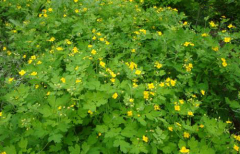
Celandine (Greater) Extract
| Min. Order: | 1 Kilogram |
|---|---|
| Trade Term: | FOB |
| Payment Terms: | T/T, WU |
| Supply Ability: | 1000kg/week |
Company Profile
| Location: | China (Mainland) |
|---|---|
| Business Type: | Manufacturer |
Product Detail
| Means of Transport: | Ocean |
|---|---|
| Production Capacity: | 1000kg/week |
| Packing: | 25kg/drum or1kg/bag |
| Delivery Date: | within 5 days after payment |
Product Description
Celandine (Greater) Extract
Active Ingredient: Chelerythrine chloride
Specification: 10%
Test Method: HPLC
Celandine (Greater) Extract Chelidonium majus L Chelerythrine chloride
Celandine (Greater) Extract Chelidonium majus L Chelerythrine chloride
HS-No. 29392900
C21H38NO4CL ? Mr 383.8 ? CAS-No. [3895-92-9]
(1,2-Dimethoxy-N-methyl[1,3]benzodioxolo[5,6-c]phenanthridinium chloride). A naturally occurring benzophenanthridine alkaloid isolated from Chelidonium majus L. Potent and cell-permeable inhibitor of protein kinase C. Induces apoptosis in HL-60 human promyelocytic leukemia cells.
Assay (TLC) min. 95 %
Chelidonium majus (greater celandine; in Europe tetterwort, although in America the same name refers to bloodroot) is a herbaceous perennial plant, the only species in the genus Chelidonium. It is native to Europe and western Asia and introduced widely in North America.
The lesser celandine belongs to the same order (Ranunculales) as the greater celandine, but belongs to the buttercup family, whereas the greater celandine belongs to the poppy family.
The whole plant is toxic in moderate doses as it contains a range of isoquinoline alkaloids but there are numerous therapeutic uses when used at the correct dosage.The main alkaloid present in the herb and root is coptisine. Other alkaloids present include berberine, chelidonine, sanguinarine and chelerythrine. Sanguinarine is particularly toxic with an LD50 of only 18 mg per kg body weight. Despite this acute toxicity, sanguinarine is present in such small quantities that the LD50 dose would require >50g of raw herb to be ingested. Caffeic acid derivatives are also present.
The effect of the fresh herb is of a mild analgesic, cholagogic, antimicrobial, oncostaticand central nervous system sedative. In animal tests, celandine is shown to be cytostatic. An immune stimulating effect has also been noted. Some studies show that the alkaloid extraction can have the same effects. The alkaloids are known to cause immobilization in mice after being taken orally or injected. The alkaloids cause limpness and tone reduction of smooth muscle in rabbits. The alkaloids are also noted to stimulate the heart and lungs of frogs, cats and dogs, raising the blood pressure and widening the arteries.
The latex could be employed as a caustic for healing small open wounds. Early studies of celandine showed that it causes contact dermatitis and eye irritation, particularly from contact with the poisonous red to yellow latex sap of the stem. This effect has not been observed in animal studies; no inflammation was observed in rabbit eye tests. The latex can leave a non-permanent stain. Stains on skin of the fingers are sometimes reported to cause eye irritation after rubbing the eyes or handling contact lenses. When any part of the plant causes eye irritation, wash it out with clear water and when needed seek medical help. The latex is also known to stain clothes.
The characteristic latex also contains proteolytic enzymes and the phytocystatin chelidostatin, a cysteine protease inhibitor.These co-constituents could explain the topical use of greater celandine against warts and moles.
Greater celandine acts as a mild sedative which has been used historically to treat asthma, bronchitis, and whooping cough. The herb's antispasmodic effect improves bile flow in the gallbladder and has been reputed to treat gallstones and gallbladder pain. As far back as Pliny the Elder and Dioscorides (1st century CE) this herb has been recognized as a useful detoxifying agent. The root has been chewed to relieve toothache.




